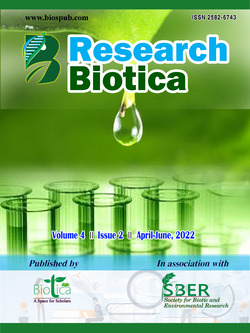
Proteomics of Cotton Fiber Development
A. Manivannan*
ICAR-Central Institute for Cotton Research, Regional Station, Coimbatore, Tamil Nadu (641 003), India
Amal T. Cheeran
ICAR-Central Institute for Cotton Research, Regional Station, Coimbatore, Tamil Nadu (641 003), India
DOI: https://doi.org/10.54083/ResBio/4.2.2022/47-50
Keywords: Cotton, Development, Fiber, Metabolism, Proteomics
Abstract
Cotton is one of the major sources for natural fiber with strong commercial relevance. Now a day, there is a substantial demand for the extra-long, strong and fine cotton fibres are the major choices of modern textile industry. The most efficient way to improve fiber quality is through breeding. However, it is a big challenge for cotton breeders to develop a cultivar having good fiber quality along with higher yield because a negative genetic correlation widely exists between quality and yield. However, complete draft genome sequence of cotton is now available, but functional genomic studies remain in their infancy, as this exhibit genetic constrains like recalcitrance and complex genome. Proteomics is an established complementary tool to genomics provides a powerful tool for functional analysis of cotton fiber productivity. In this review, a special emphasis is given to cotton fiber proteomics in response to fiber biogenesis, fiber quality and fiber colour that will give a better understanding for molecular basis of acquisition of fiber developmental mechanism. Various biological and molecular pathways that are mostly carried out and controlled by proteins guide this dynamic process of cotton fibre development. An integrating proteome data with genome information from cotton will provide exciting outcome for high quality fiber and yield to attain long-term goals of cotton sustainable production.
Downloads
not found
Reference
Graves, D.A., Stewart, J.M., 1988. Chronology of the differentiation of cotton (Gossypium hirsutum L.) fiber cells. Planta 175(2), 254-258.
Jiang, J., Shi, Z., Ma, F., Liu, K., 2022. Identification of key proteins related to high-quality fiber in upland cotton via proteomics analysis. Plant Cell Reports 41(4), 893-904.
Kim, H.J., Triplett, B.A., 2001. Cotton fiber growth in planta and in vitro. Models for plant cell elongation and cell wall biogenesis. Plant Physiology 127(4), 1361-1366.
Lee, C.M., Kafle, K., Belias, D.W., Park, Y.B., Glick, R.E., Haigler, C.H., Kim, S.H., 2015. Comprehensive analysis of cellulose content, crystallinity, and lateral packing in Gossypium hirsutum and Gossypium barbadense cotton fibers using sum frequency generation, infrared and Raman spectroscopy, and X-ray diffraction. Cellulose 22(2), 971-989.
Li, Y.J., Sun, S.C., Zhang, X.Y., Wang, X.F., Liu, Y.C., Fei, X., Jie, S.U.N., 2018. New clues concerning pigment biosynthesis in green colored fiber provided by proteomics-based analysis. Journal of Integrative Agriculture 17(1), 46-53.
Li, Y.J., Zhang, X.Y., Wang, F.X., Yang, C.L., Liu, F., Xia, G.X., Sun, J., 2013. A comparative proteomic analysis provides insights into pigment biosynthesis in brown color fiber. Journal of Proteomics 78, 374-388.
Pang, C.Y., Wang, H., Pang, Y., Xu, C., Jiao, Y., Qin, Y.M., Western, T.L., Yu, S.X., Zhu, Y.X., 2010. Comparative proteomics indicates that biosynthesis of pectic precursors is important for cotton fiber and Arabidopsis root hair elongation. Molecular & Cellular Proteomics 9(9), 2019-2033. DOI: 10.1074/mcp.M110.000349.
Ruan, Y.L., Chourey, P.S., 1998. A fiberless seed mutation in cotton is associated with lack of fiber cell initiation in ovule epidermis and alterations in sucrose synthase expression and carbon partitioning in developing seeds. Plant Physiology 118(2), 399-406.
Saravanan, R.S., Rose, J.K., 2004. A critical evaluation of sample extraction techniques for enhanced proteomic analysis of recalcitrant plant tissues. Proteomics 4(9), 2522-2532.
Stewart, J.M., 1975. Fiber initiation on the cotton ovule (Gossypium hirsutum). American Journal of Botany 62(7), 723-730.
Turley, R.B., Ferguson, D.L., 1996. Changes of ovule proteins during early fiber development in a normal and a fiberless line of cotton (Gossypium hirsutum L.). Journal of Plant Physiology 149(6), 695-702.
Wan, C.Y., Wilkins, T.A., 1994. A modified hot borate method significantly enhances the yield of high-quality RNA from cotton (Gossypium hirsutum L.). Analytical Biochemistry 223(1), 7-12.
Wang, X.C., Li, Q., Jin, X., Xiao, G.H., Liu, G.J., Liu, N.J., Qin, Y.M., 2015. Quantitative proteomics and transcriptomics reveal key metabolic processes associated with cotton fiber initiation. Journal of Proteomics 114, 16-27.
Wang, Y., Zheng, M., Gao, X., Zhou, Z., 2012. Protein differential expression in the elongating cotton (Gossypium hirsutum L.) fiber under nitrogen stress. Science China Life Sciences 55(11), 984-992.
Yao, Y., Yang, Y.W., Liu, J.Y., 2006. An efficient protein preparation for proteomic analysis of developing cotton fibers by 2‐DE. Electrophoresis 27(22), 4559-4569.
Zhang, B., Du, S.J., Hu, J., Miao, D., Liu, J.Y., 2016. Comparative proteomic analyses of Asian cotton ovules with attached fibers in the early stages of fiber elongation process. Proteome Science 14(1), 1-8.
Zhou, X., Hu, W., Li, B., Yang, Y., Zhang, Y., Thow, K., Fan, L., Qu, Y., 2019. Proteomic profiling of cotton fiber developmental transition from cell elongation to secondary wall deposition. Acta Biochim Biophys Sin (Shanghai) 51(11), 1168-1177. DOI: 10.1093/abbs/gmz111.
Zhu, L., Dou, L., Shang, H., Li, H., Yu, J., Xiao, G., 2021. GhPIPLC2D promotes cotton fiber elongation by enhancing ethylene biosynthesis. iScience 24(3), 102199.
